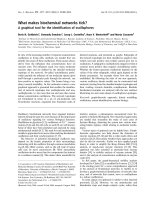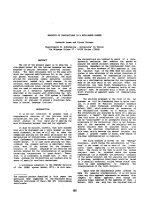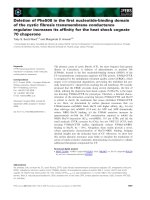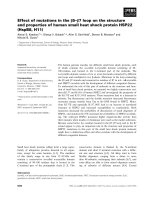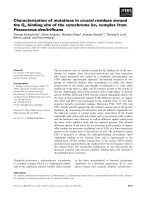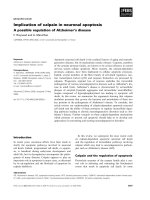Báo cáo khoa học: " Comparisons of Sampling Procedures and Time of Sampling for the Detection of Salmonella in Danish Infected Chicken Flocks Raised in Floor Systems" pptx
Bạn đang xem bản rút gọn của tài liệu. Xem và tải ngay bản đầy đủ của tài liệu tại đây (76.63 KB, 10 trang )
Gradel KO, Andersen J, Madsen M: Comparisons of sampling and time of sam-
pling for the detection of Salmonella in Danish infected chicken flocks raised in
floor systems. Acta vet. scand. 2002, 43, 21-30. – Bacteriological follow-up samples
were taken from 41 chicken (Gallus gallus) flocks in floor systems, where Salmonella
enterica (Salmonella) had been detected either directly in bacteriological samples or in-
directly by serological samples. Three types of follow-up samples were compared to
each other within each flock: 1) 5 pairs of socks, analysed as 5 samples, 2) 2 pairs of
socks, analysed as one sample, and 3) 60 faecal samples, analysed as one pooled sam-
ple. Agreement between sampling methods was evaluated by the following statistical
tests: ‘Kappa’, ‘The adjusted rand’, McNemar´s test for marginal symmetry, Proportion
of agreement P
0
, P
+
, P
-
, and Odds Ratio. The highest agreement was found between the
2 types of sock sampling, while the lowest agreement was found by comparing 60 fae-
cal samples with 5 pairs of socks. Two pairs of socks analysed as one pool appeared to
be just as effective in detecting S. enterica as the 60 faecal samples. In broiler flocks, 5
pairs of socks were used both in the routine samples taken at about 3 weeks of age for
the establishment of infection of the flock, and as one of the follow-up samples taken
shortly before slaughter age, which means that the only notable differences between the
2 sampling rounds were the age of the broilers and of their litter. S. enterica was detected
more frequently in samples from broilers about 3 weeks old, than in similar samples
taken from broilers a few days prior to slaughter at ca. 33-40 days of age.
sampling methods; sampling time.
Acta vet. scand. 2002, 43, 21-30.
Acta vet. scand. vol. 43 no. 1, 2002
Comparisons of Sampling Procedures and Time of
Sampling for the Detection of Salmonella in Danish
Infected Chicken Flocks Raised in Floor Systems
By K. O. Gradel
1
, J. Andersen
2
and M. Madsen
1
1
Department of Poultry, Fish and Fur-bearing Animals, Aarhus,
2
Danish Zoonosis Centre, Copenhagen and Dan-
ish Veterinary Institute, Denmark.
Abbreviations:
BPW: Buffered peptone water.
ELISA: Enzyme-Linked Immunosorbent
Assay.
ISO: International Organization for Standard-
ization.
LPS: Lipopolysaccharide.
LPS-ELISA: Lipopolysaccharide Enzyme-
Linked Immunosorbent Assay.
RVS: Rappaport Vassiliadis broth with soy
peptone.
Introduction
Routine Salmonella surveillance has been
performed in all Danish broiler flocks since
1989 (Bisgaard 1992, Anon. 1999a), first as a
voluntary programme by the Danish Poultry
Council and since 1992 as a component of the
statutory Ante-mortem inspection programme
for broiler flocks. As from the start of the
surveillance programmes caecal tonsils from
16 chickens per flock were tested. Assuming a
test sensitivity of 1.00, this sampling procedure
could with 90% confidence detect salmonella-
positive flocks with a prevalence of 20% (Skov
et al. 1999). At the end of 1994 a new sampling
procedure was implemented, comprising 60
faecal samples per flock analysed as 12 samples
with 5 pooled faecal samples each. This sam-
pling procedure improved the sensitivity to a
prevalence detection and confidence of 5% and
95%, respectively (Skov et al. 1999). In 1997,
five pairs of elastic cotton tubes, worn over the
boots during a walk in the broiler house (“sock
samples”) substituted the faecal samples after
Skov et al. (1999) carried out an investigation
indicating that this did not compromise the sen-
sitivity.
In 1994 the EU Zoonoses Directive (Directive
92/117/EEC) was implemented in Denmark in
order to carry out surveillance and control mea-
sures in parent rearing and breeder chicken
flocks. However, in December 1996 further leg-
islation instituting the Danish Salmonella Con-
trol Programme was introduced in order to par-
ticularly intensify the surveillance of parent
breeder flocks by the implementation of a sam-
pling programme consisting of 60 faecal sam-
ples collected from each house with parent
flocks every 4 weeks (Feld et al. 2000). The
Danish Salmonella Control Programme thus
lays down statutory requirements for routine
Salmonella sampling procedures as well as the
consequences for the flocks if Salmonella is de-
tected in these routine samples (Anon. 1999a).
Since 1996 the routine sampling programme
and the salmonella situation have been fre-
quently scrutinised by all parties involved in the
Salmonella Control Programme in order to pos-
sibly improve the sensitivity of detecting
Salmonella. Some hatcheries have supple-
mented the statutory faecal samples with vol-
untary sock samples in the hope of detecting a
Salmonella infection at an earlier stage, and in
May 2000 sock samples have substituted the 60
faecal samples as sampling material in the Dan-
ish Salmonella Control Programme.
The main aim of the study was to compare one
pool of 60 faecal samples to one pool consist-
ing of 2 pairs of socks, collected from chicken
houses where Salmonella had been detected,
and where the animals were housed in floor sys-
tems. Five pairs of socks were also included in
the study as reference samples.
In broiler houses 5 pairs of socks were used
both in routine samples, taken at about 3 weeks
of age (Anon. 1999a) and used for the primary
identification of infected flocks to be included
in the study, and in the follow-up samples, typ-
ically taken a few days before slaughtering the
animals. This provided an opportunity for
studying infection dynamics in broiler flocks by
comparing the number of Salmonella positive
samples between 2 different ages of broilers
within the same house and flock.
Materials and methods
Chicken flocks
The Danish Veterinary Institute receives all
Salmonella samples submitted under the Dan-
ish Salmonella Control Programme for parent
and table-egg producing flocks, as well as Ante-
mortem Salmonella samples from broiler flocks
prior to slaughter. Thus it is possible centrally
to follow the Salmonella infection status of all
commercial Danish chicken flocks.
The analytical unit of this study was the
Salmonella-infected flock, defined as a group
of chickens of the same age, raised in a floor
system in the same house during the same pe-
riod, and infected with S. enterica prior to sam-
pling. Houses with broilers, rearing stock on
floor, and table egg layers in either free range,
deep litter or organic systems fulfilled the crite-
ria for the animals being raised in floor systems.
Altogether 41 flocks were included in the study,
which covered the period from 16 August 1999
until 5 May 2000. Among the 41 flocks, 29
were broiler flocks, one was a rearing flock
while the remaining 11 flocks were table layers
22 K. Gradel et al.
Acta vet. scand. vol. 43 no. 1, 2002
(6 flocks on deep litter, 4 organic flocks and 1
free range flock). The number of investigated
flocks distributed on production category and
Salmonella serovar is shown in Table 1.
Sampling procedures
Broiler flocks: As part of the statutory
Ante-mortem programme 5 pairs of sock sam-
ples are routinely submitted from each broiler
flock when the broilers are about 3 weeks old,
according to procedures described by Skov et
al. (1999). Whenever Salmonella was detected
in routine sock samples, either the person in
charge of the broiler flock or the local District
Veterinary Officer was contacted in order to ob-
tain follow-up samples for this study. Typically,
the samples were taken a few days prior to
slaughtering the broilers.
Layer flocks: During the period of the study
all layer flocks were monitored under the Dan-
ish Salmonella Control Programme by bacteri-
ological analysis of 60 faecal samples as well as
by serological analysis by an indirect
lipopolysaccharide (LPS) ELISA including
Salmonella 1,4,5,9,12 O-antigens (MIX-
ELISA) (Feld et al. 2000) of 60 eggs or 60
blood samples for antibodies against
Salmonella, at a frequency of 6 times/year. Pos-
itive findings in routine samples were con-
Procedures for detection of Salmonella in chicken 23
Acta vet. scand. vol. 43 no. 1, 2002
Table 1. Chicken flocks under study as distributed on production category and detected Salmonella enterica
serovars.
Category (number No. of Serovar(s) detected at follow-up
of flocks) flocks
Serovar(s) detected at inclusion time
(number of flocks)
Broilers (29) 6 4.12:b:- 4.12:b:- (2)
1 41:z4,z24:- None
1 Brevis None
1 Derby None
1 Indiana Infantis Typhimurium, DT177
1
, Indiana (1)
4 Infantis Infantis (3)
2 Kentucky None
1 Senftenberg None
1 Typhimurium, DT110 Typhimurium, DT110 (1)
1 Typhimurium, DT12 None
1 Typhimurium, DT177, Indiana Typhimurium, DT177 (1)
8 Typhimurium, DT41 Typhimurium, DT41 (5)
1 Typhimurium, DT66 Typhimurium, DT66 (1)
Layer poults (1) 1 Enteritidis, PT8
2
None
Deep litter egg 1 Enteritidis, PT RDNC
3
Enteritidis, PT21 (1)
layers (6) 3 Enteritidis, PT6 Enteritidis, PT RDNC, rough (2)
1 Enteritidis, PT8 None
1 Serological confirmation only Enteritidis, PT2 (1)
Organic egg layers 3 Enteritidis, PT6 Enteritidis, PT6 (1)
(4) 1 Enteritidis, PT8 Enteritidis, PT8 (1)
Free range egg
layers (1) 1 Serological confirmation only Enteritidis, PT8 (1)
1) DT = definitive type. 2) PT = phage type. 3) Routine dilution, no conformity.
firmed once more either by bacteriological
analysis (nine flocks) or by positive serological
reactions (2 flocks) before inclusion in the
study.
Samples investigated: The samples inves-
tigated for all the 41 flocks were:
• 5 pairs of socks, analysed as 5 samples (“5-
sock-samples”).
• 2 pairs of socks, analysed as one sample (“2-
sock-samples”).
• 60 faecal samples, analysed as one sample.
Each faecal sample contained about one
gram of fresh faecal material.
However, 2-sock-samples were not received
from 2 flocks, and 5-sock-samples were not re-
ceived from one flock.
Sample collections: Owners of infected
flocks, all of whom were familiar with collect-
ing Salmonella samples, were contacted in or-
der to obtain the samples for this study. In order
for sampling procedures to reflect ordinary
sample collections, these owners received no
additional instructions on how to collect the
samples. All samples were collected in houses
with animals, with the exception of samples
from one table egg layer house on deep litter
where the animals had just been removed, and
from 3 organic layer houses where only few an-
imals remained at the time of sampling.
Laboratory procedures
Bacteriological samples were analysed by a
modified ISO 6579 method (Anon. 1993).
Briefly, the samples were immersed in buffered
peptone water (BPW) (Merck 07228) at a
weight ratio of 1:10. After incubation at 37°C
for 16-20 h, 100 µl of BPW was transferred to
10 ml of Rappaport Vassiliadis broth with soy
peptone (RVS) (OXOID CM 866) and incu-
bated at 42°C for 18-24 h. 10 µl of RVS was
then spread on Rambach agar (Merck 07500)
and incubated at 37°C for 20-24 h. Up to 5 sus-
pected colonies were tested serologically by
Kaufmann methods (Popoff & Le Minor 1997).
Data analysis and statistics
Data were recorded in a database programme
(Anon. 1997a). Statistical analysis was per-
formed in an Excell spreadsheet (Anon. 1997b),
in Splus-2000 (Anon. 1999b) and in SAS (SAS
Institute Inc. 1999).
The observed data were summarised in contin-
gency tables, cross-classified as Salmonella
positive/negative. Several methods are avail-
able for testing and comparing the agreement of
the applied sample types. In the current study
the following methods were chosen: Cohen’s
Kappa (κ) (Cohen 1960), The Adjusted Rand
R’ (Hubert & Arabie 1985), McNemars test for
marginal symmetry (Fleiss 1981), Proportion
of agreement P
0
, P
+
,P
-
, and Odds Ratio OR
(Fleiss 1981).
Comments on and interpretation of the
statistics
Cohen’s Kappa (κ) is a popular way of quanti-
fying level of agreement, however, a few com-
ments should be added to this frequently ap-
plied statistic. In the calculation of κ, the
proportion of chance agreement is calculated
and corrected for, this would only be appropri-
ate and relevant under the conditions of statisti-
cal independence – which is clearly not the
case. Landis & Koch ( 1977) suggest that κ be
interpreted as (see the table).
The Rand statistic R is an objective criterion for
24 K. Gradel et al.
Acta vet. scand. vol. 43 no. 1, 2002
Kappa Value Below 0 0-0.2 0.21-0.40 0.41-0.6 0.61-0.8 0.81-1.0
Interpretation Poor Slight Fair Moderate Substantial Almost perfect
evaluation of classification. It measures the pro-
portion of coplaced pairs (Hubert & Arabie
1985). The Adjusted Rand statistic R’ is nor-
malised so that it is zero when classification is
selected by chance and 1 when a perfect match
is achieved.
McNemar's test statistic is used to test the null
hypothesis of marginal symmetry, namely that
the probability of an observation being classi-
fied into cell [i,j] in the contingency table is the
same as the probability of being classified into
cell [j,i] (Fleiss 1981). The p-value should be
interpreted carefully. Its validity depends on the
assumption that the cell counts are at least mod-
erately large. Even when cell counts are ade-
quate, the chi-square is only a large-sample ap-
proximation to the true distribution of
McNemar’s statistic under the null hypothesis.
Proportion of overall agreement P
0
and propor-
tion of specific agreement P
+
and P
-
are impor-
tant descriptive statistics. P
0
is the proportion of
samples for which the sample types agree (it
does not distinguish between positive and neg-
ative agreement). P
+
and P
-
is the proportion of
specific agreement for positive and negative
ratings, respectively. They may be interpreted
as conditional probabilities – if both are high
the agreement is high.
The Odds Ratio can be interpreted as the rela-
tive increase in the odds of one sample type
making a given classification given that the
other sample type made the same classification.
Since all statistics have pros and cons we have
chosen to list several statistics in order to inter-
pret the results.
Results
General
Thirty-nine of the 41 flocks under study were
included due to positive results of bacteriologi-
cal culture for Salmonella in routine surveil-
lance samples. In 37 of the 39 flocks there was
no discrepancy between the S. enterica serovar
found in routine samples and in the Salmonella
positive follow-up samples. The remaining 2
flocks were broiler flocks where 2 Salmonella
serovars were found in the routine sock samples
from each flock. Only one of the detected
Salmonella serovars was found in the follow-up
samples, cf. Table 1.
Two flocks were included in the study due to
serologically positive routine samples for
Salmonella. In both of these flocks S. Enteri-
Procedures for detection of Salmonella in chicken 25
Acta vet. scand. vol. 43 no. 1, 2002
Table 2. Comparisons between three sample types
for the detection of Salmonella in infected chicken
flocks
1a: Faecal samples and 2-sock-samples
Faecal
2-sock-samples
2
Total
samples
1
+ Salm - Salm
+ Salm
4
10 3 13
- Salm
5
62026
Total 16 23 39
1b: Faecal samples and 5-sock-samples
Faecal
5-sock-samples
3
Total
samples
+ Salm - Salm
+ Salm 9 3 12
- Salm 9 19 28
Total 18 22 40
1c: 2-sock-samples and 5-sock-samples
2-sock-
5-sock-samples
Total
samples
+ Salm - Salm
+ Salm 13 2 15
- Salm 4 19 23
Total 17 21 38
Numbers in the tables show the number of flocks.
1)
60 faecal droppings, analysed as one sample;
2)
2 pairs of
socks, analysed as one sample;
3)
5 pairs of socks, analysed
as 5 samples;
4)
Salmonella detected;
5)
Salmonella not de-
tected.
tidis, a serovar sharing O-antigens with the rou-
tine LPS-ELISA employed, were found in the
follow-up samples.
Comparing different sample types
Table 2 presents comparisons between the 3
sample types in this study. No single sample
type was able to detect Salmonella in all the
flocks that were found Salmonella positive in
the routine samples (faecal samples: 32%, 2-
sock-samples: 41% and 5-sock-samples: 45%).
Table 3 lists the statistics applied to evaluate the
agreement between the sample types. Using the
5-sock-samples as reference (or the “golden
standard”), the lowest level of agreement, for
all statistics, was found between faecal samples
and 5-sock-samples. The 9 flocks where Sal-
monella was found in the 5-sock-samples, but
not in the faecal samples, contributed to this
relatively low level of agreement. The highest
level of agreement, for all statistics, was found
between 2-sock-samples and 5-sock-samples,
showing a substantial agreement between these
two tests. In 4 flocks Salmonella was found in
5-sock-samples, but not in 2-sock-samples.
There was a moderate agreement between fae-
cal samples and 2-sock-samples. In 6 flocks
Salmonella was detected in 2-sock-samples,
but not in the faecal samples, while the opposite
was the case for 3 flocks.
Comparing routine sock samples and 5-sock-
samples in broiler flocks
More than one Salmonella serovar was found in
26 K. Gradel et al.
Acta vet. scand. vol. 43 no. 1, 2002
Table 3. Statistics used for, and results of comparisons between three sample types for the detection of
Salmonella in infected chicken flocks.
Statistics
Faecal samples and Faecal samples and 2-sock-samples and
2-sock-samples 5-sock-samples 5-sock-samples
κ
1
[95% confidence interval] 0.51 [0.23 ; 0.78] 0.38 [0.10 ; 0.65] 0.68 [0.44 ; 0.94]
R´
2
0.27 0.14 0.45
Mcnemar (p-value)
3
0.317 0.083 0.414
OR
4
[95% confidence interval] 11.1 [2.28 ; 54.0] 6.33 [1.37 ; 29.2] 30.9 [4.91 ; 194]
P
o
, P
+
, P
-
5
0.77 , 0.68, 0 .82 0.70 , 0.70 , 0.76 0.84, 0.81 , 0,86
1)
Cohen´s Kappa;
2)
Adjusted Rand R´;
3)
McNemar´s test for marginal symmetry;
4)
Odds Ratio;
5)
Proportion of agreement.
Table 4. Comparison of results of sampling of 26 Salmonella infected broiler flocks at 3 weeks of age,
and at slaughter age by 5 pairs of sock samples.
No. of Salmonella positive samples at slaughter age
012345
No. of 1 10 10
Salmonella 2 2 3
positive 3 2 2
samples at 4 2 1 1 4
3 weeks of 5 1 2 4 7
age
16 2 3 5 26
Numbers in the table show the number of flocks.
2 of the flocks and this may possibly bias the
number of Salmonella positive socks. More-
over, 5-sock-samples were not submitted from
one flock. These 3 flocks were consequently ex-
cluded from further analyses.
Table 4 compares the numbers of Salmonella
positive flocks in routine samples and in 5-
sock-samples for the remaining 26 broiler
flocks. In 16 flocks, where Salmonella was de-
tected in the routine samples (ranging from 1 to
4 Salmonella positive sock samples), Sal-
monella was not detected in 5-sock-samples.
From 2 flocks, where Salmonella was found in
4 and 5 of the routine sock samples, respec-
tively, Salmonella was only detected in one 5-
sock-sample. Among 7 flocks, which were all
highly infected in the routine samples, there
was a good correlation between routine sam-
ples and 5-sock-samples. A lower number of
Salmonella positive socks in the routine sam-
ples than in the 5-sock-samples was only de-
tected in one flock. The agreement statistics,
shown in table 5, indicate a very poor – if any –
level of agreement.
For the 26 flocks the time elapse between re-
ceiving the routine sock samples and the 5-sock
samples was in the range of 10-24 days, with
“time elapse peaks” at 14, 15, 16 and 20 days,
for 5, 3, 4 and 5 flocks, respectively (data not
shown).
Discussion
Several studies have compared the sensitivity
and power of sampling methods in chicken
houses (Kingston 1980, Higgins et al. 1982,
Caldwell et al. 1995, Byrd et al. 1997, Caldwell
et al. 1998, Skov et al. 1999). Skov et al. (1999)
concluded that 5 pairs of socks seemed to be as
effective in detecting Salmonella as 12 faecal
pools, each pool consisting of 5 faecal samples.
The same study also compared one pair of
socks to faecal samples and concluded that this
sample type was inferior to the 12 × 5 faecal
samples for the purpose of detecting Sal-
monella in broiler flocks. In the period between
March 1998 and May 2000 one Danish broiler
hatchery submitted voluntary sock samples
from all its parent stock houses (1-3 pairs of
socks from each house, depending on the num-
ber of animals) in addition to the statutory sam-
ples under the Danish Salmonella Control Pro-
gramme. During that period Salmonella was
found in sock samples submitted from 3 differ-
ent parent stock houses, which were situated at
3 different farms while during the same period
no Salmonella was found in the corresponding
statutory 1 × 60 faecal samples. This difference
in Salmonella detection ability between the 2
sample types could be due to the fact that the
private sock samples were submitted every
week, whereas the obligatory faecal samples
were only submitted every 4 weeks, but it could
also be due to an improved ability of the sock
samples to detect Salmonella as compared to
faecal samples. Because Salmonella is rarely
detected in samples from parent stock in Den-
mark, both egg layers, layer poults and broiler
chickens raised in floor systems were included
in this study in order to provide positive mate-
rial for the investigation. The results show that
2 pairs of socks, analysed as one pool, do not
seem to be inferior in detecting Salmonella
when compared to 1 × 60 faecal samples, i.e.
they can detect a 5% Salmonella prevalence
Procedures for detection of Salmonella in chicken 27
Acta vet. scand. vol. 43 no. 1, 2002
Table 5. Statistics used for, and results of compar-
isons between sampling of 26 Salmonella infected
broiler flocks at 3 weeks of age, and at slaughter age
by 5 pairs of sock samples.
Statistics Routine 5-sock-samples
and 5-sock-samples
κ [95% confidence interval] -0.01 [-0.27 ; 0.24]
R´ 0.32
OR [95% confidence interval] 0.89 [0.13 ; 6.16]
P
0
0.11
Legends: See Table 3.
with 95% confidence, given that the laboratory
sensitivity is 1.00.
Comparison of 5 pairs of socks in broiler flocks
between about 3 weeks of age and a few days
prior to slaughter clearly indicated that many
Salmonella positive flocks will not be detected
if the sampling is postponed until a few days
prior to slaughter. This may be due to changes
in Salmonella excretion by the chickens during
the period they are reared in the house, and/or it
may be due to adverse factors for Salmonella
survival in the litter. Most studies, which de-
scribe how different factors may influence the
Salmonella excretion rates in chickens, are ex-
perimental (Snoeyenbos et al. 1978, Weinack et
al. 1979, Gustafson & Kobland 1984, Desmidt
et al. 1998, Muir et al. 1998, Skov et al. 2000).
The age of the inoculated chickens, using new
or used litter, Salmonella inoculation dose, and
presence or absence of feed additives are a few
examples of factors which may influence the
time and amount of Salmonella being excreted
by chickens. It is difficult to estimate the im-
portance of these factors in this study because
we do know neither the time of infection nor the
infective dose, the latter of which is probably
lower than in the experimental studies (Muir et
al. 1998). However, based on Ante-mortem re-
sults and hatchery records, 8 of the 26 broiler
flocks received S. Typhimurium definitive type
41 (ST41) from a Swedish parent flock, 11
flocks were in broiler houses with persistent
Salmonella infections, while the remaining 7
flocks had Salmonella types, which occurred
sporadically, making it difficult to trace the
source of infection (Kim Gradel, pers. obs.).
There was no difference between reduction
rates from routine samples to 5-sock-samples
when these 3 groups were compared to each
other (data not shown), which can be a genuine
tendency, but which may also be due to the low
number of flocks within each of the groups.
However, the day-old chicks were Salmonella
positive in the flocks with ST41, and it is likely
that the chicks in the persistently infected
houses became Salmonella positive within a
few days after their arrival to the houses, be-
cause they are more prone to get a Salmonella
infection before the intestinal microbial flora is
established (Desmidt et al. 1998). Several stud-
ies have described conditions in the litter which
can influence the Salmonella status of broiler
flocks (e.g. Turnbull & Snoeyenbos 1973,
Weinack et al. 1979, Opara et al. 1992, Carr et
al. 1995). An increase in ammonia contents and
pH in the litter is generally seen during the pe-
riod when the broilers are raised in the houses,
and these increases are detrimental to the sur-
vival of Salmonella (Turnbull & Snoeyenbos
1973). Other factors such as water activity and
moisture content also have a great impact on the
survival of Salmonella in litter (Turnbull &
Snoeyenbos 1973, Opara et al. 1992, Carr et al.
1995), however, as these factors are not clearly
related to the age of the litter it is more difficult
to estimate their practical relevance in this
study.
In conclusion, this study indicated that sam-
pling faecal material from Salmonella infected
chicken flocks by means of 2 pairs of socks
worn on the footwear and analysed as one pool,
was at least as effective in detecting Salmonella
as hand collection of 60 samples of fresh faecal
material analysed as one pool. Moreover, it has
clearly been shown that, under the present con-
ditions in Danish broiler production, sock sam-
ples taken in broiler houses at about 3 weeks of
age are more effective in detecting Salmonella
than sock samples taken a few days prior to
slaughter.
Acknowledgements
The Salmonella laboratory technicians and Jens
Christian Jørgensen at the Danish Veterinary Institute
in Aarhus, the District Veterinary Officers and the
poultry farmers are thanked for excellent collabora-
tion.
28 K. Gradel et al.
Acta vet. scand. vol. 43 no. 1, 2002
References
Anonymous: Microbiology – General guidance on
methods for the detection of Salmonella. ISO
6579: 1993(E), 1-16. 1993.
Anonymous: Microsoft Access, version 97, 1989-
1997. Microsoft Corporation. 1997a.
Anonymous: Microsoft Excel 97 SR-2. 1985-1997.
Microsoft Corporation. 1997b.
Anonymous: Annual report on zoonoses in Denmark
1999, 1-28. 1999a.
Anonymous: S-plus 2000 professional Release 2,
Mathsoft inc. 1999b.
Bisgaard M: A voluntary Salmonella control pro-
gramme for the broiler industry, implemented by
the Danish Poultry Council. Int. J. Food Microb.
1992, 15, 219-224.
Byrd JA, Corrier DE, DeLoach JR, Nisbet DJ: Com-
parison of drag-swab environmental protocols for
the isolation of Salmonella in poultry houses.
Avian Dis. 1997, 41, 709-713.
Caldwell DJ, Hargis BM, Corrier DE, Vidal L, De-
Loach JR: Evaluation of persistence and distribu-
tion of salmonella serotype isolation from poul-
try farms using drag-swab sampling. Avian Dis.
1995, 39, 617-621.
Caldwell DJ, Hargis BM, Corrier DE, DeLoach JR:
Frequency of isolation of Salmonella from pro-
tective foot covers worn in broiler houses as com-
pared to drag-swab sampling. Avian Dis. 1998,
42, 381-384.
Carr LE, Mallinson ET, Tate CR, Miller RG, Russek-
Cohen E, Stewart LE, Opara OO, Joseph SW:
Prevalence of Salmonella in broiler flocks: Effect
of litter, water activity, house construction and
watering devices. Avian Dis. 1995, 39, 39-44.
Cohen J: A coefficient of agreement for nominal
scales. Educ. Psychol. Meas. 1960, 20, 37-46.
Desmidt M, Ducatelle R, Haesebrouck F: Serological
and bacteriological observations on experimental
infection with Salmonella hadar in chickens. Vet.
Microbiol. 1998, 60, 259-269.
Feld NC, Ekeroth L, Gradel KO, Kabell S, Madsen M:
Evaluation of a serological Salmonella Mix-
ELISA for poultry used in a national surveillance
programme. Epidemiol. Infect. 2000, 125, 263-
268.
Fleiss JL: Statistical Methods for Rates and Propor-
tions. 1981, 2. ed. Wiley. New York, 1981.
Gustafson RH, Kobland JD: Factors influencing
salmonella shedding in broiler chickens. J. Hyg.
Camb. 1984, 92, 385-394.
Higgins R, Malo R, René Roberge R, Gauthier R:
Studies on the dissemination of Salmonella in
nine broiler-chicken flocks. Avian Dis. 1982, 26,
26-33.
Hubert LJ, Arabie P: Comparing proportions. J. of
Classification 1985, 2, 193-218.
Kingston DJ: A Comparison of culturing drag swabs
and litter for identification of infections with
Salmonella spp. in commercial chicken flocks.
Avian Dis. 1980, 25, 513-516.
Landis J, Koch GG: The measurement of observer
agreement for categorical data. Biometrics 1977,
33, 159-174.
Muir WI, Bryden WL, Husband AJ: Comparison of
Salmonella typhimurium
challenge models in
chickens. Avian Dis. 1998, 42, 257-264.
Opara OO, Carr LE, Russek-Cohen E, Tate CR,
Mallinson ET, Miller RG, Stewart LE, Johnston
RW, Joseph SW: Correlation of water activity and
other enviromental conditions with repeated de-
tection of salmonella contamination on poultry
farms. Avian Dis. 1992, 36, 664-671.
Popoff Michel Y, Le Minor Léon: Antigenic formulas
of the Salmonella serovars, 2-151. WHO Collab-
orating Centre for Reference and Research on
Salmonella. Paris, 1997.
SAS Institute Inc.: SAS STAT, version 8.00. 1999.
Skov MN, Carstensen B, Tornøe N, Madsen M: Eval-
uation of sampling methods for the detection of
Salmonella in broiler flocks. J. Appl. Microbiol.
1999, 86, 695-700.
Skov MN, Feld NC, Carstensen B, Madsen M: The
serological response to Salmonella Enteritidis
and S. Typhimurium in experimentally infected
chickens, followed with an indirect LPS-ELISA
and bacteriological examinations through a one-
year period. Avian Dis. 2000 (submitted).
Snoeyenbos GH, Weinack Olga M, Smyser CF: Pro-
tecting chicks and poults from salmonellae by
oral administration of “normal” gut microflora.
Avian Dis. 1978, 22, 273-286.
Turnbull PCB, Snoeyenbos GH: The roles of ammo-
nia, water activity, and pH in the salmonellacidal
effect of long-used poultry litter. Avian Dis.
1973, 17, 72-86.
Weinack Olga M, Smyser CF, Snoeyenbos GH: Eval-
uation of several methods of detecting salmonel-
lae in groups of chickens. Avian Dis. 1979, 23,
179-193.
Procedures for detection of Salmonella in chicken 29
Acta vet. scand. vol. 43 no. 1, 2002
Sammendrag
Påvisning af Salmonella i danske salmonellainfice-
rede kyllinge- og hønseflokke i gulvsystemer: Sam-
menligning af prøvemetoder og -tidspunkter.
Opfølgende bakteriologiske prøver blev udtaget fra
41 hønse-/kyllingeflokke (Gallus gallus) på dyb-
strøelse, i hvilke Salmonella enterica enten var påvist
direkte ved bakteriologiske eller indirekte ved hjælp
af serologiske undersøgelser. Følgende 3 typer af op-
følgende prøver blev sammenlignet indbyrdes inden
for flokkene: 1) 5 par sokker, analyseret som 5
prøver, 2) 2 par sokker, analyseret som én prøve, og
3) 60 gødningsprøver, analyseret som én prøve.
Overensstemmelse mellem prøvetagningsprocedu-
rerne blev undersøgt ved hjælp af følgende statistiske
tests: ’Kappa’, ’The adjusted rand’, McNemar´s test
for marginal symmetry, Proportion of agreement P
0
,
P
+
, P
-
samt Odds Ratio. Den højeste overensstem-
melse blev fundet mellem de 2 typer sokkeprøver,
mens den laveste overensstemmelse blev fundet, da
60 gødningsprøver blev sammenlignet med 5 par
sokker. To par sokker analyseret som én pool frem-
stod i undersøgelsen som lige så effektive til at de-
tektere S. enterica som de 60 poolede gødnings-
prøver. I slagtekyllingeflokke blev 5 par sokker
anvendt både i de rutinemæssige ante mortem under-
søgelser ved ca. 3 ugers alderen og som én af de op-
følgende prøver, hvor de eneste betydende forskelle
mellem prøvetagningsrunderne udgjordes af slagte-
kyllingernes og strøelsens alder. Inden for den
samme flok blev S. enterica oftere fundet i 5 par sok-
ker fra slagtekyllinger, som var cirka 3 uger gamle,
end i 5 par sokker fra slagtekyllinger, som skulle
slagtes inden for få dage.
30 K. Gradel et al.
Acta vet. scand. vol. 43 no. 1, 2002
(Received October 11, 2000; accepted October 8, 2001)
Reprints may be obtained from: Kim O. Gradel, Department of Poultry, Fish and Fur-bearing Animals, Danish
Veterinary Institute, Denmark. E-mail: , tel: 89 37 24 58, fax: 89 37 24 70/ 89 37 24 48.
